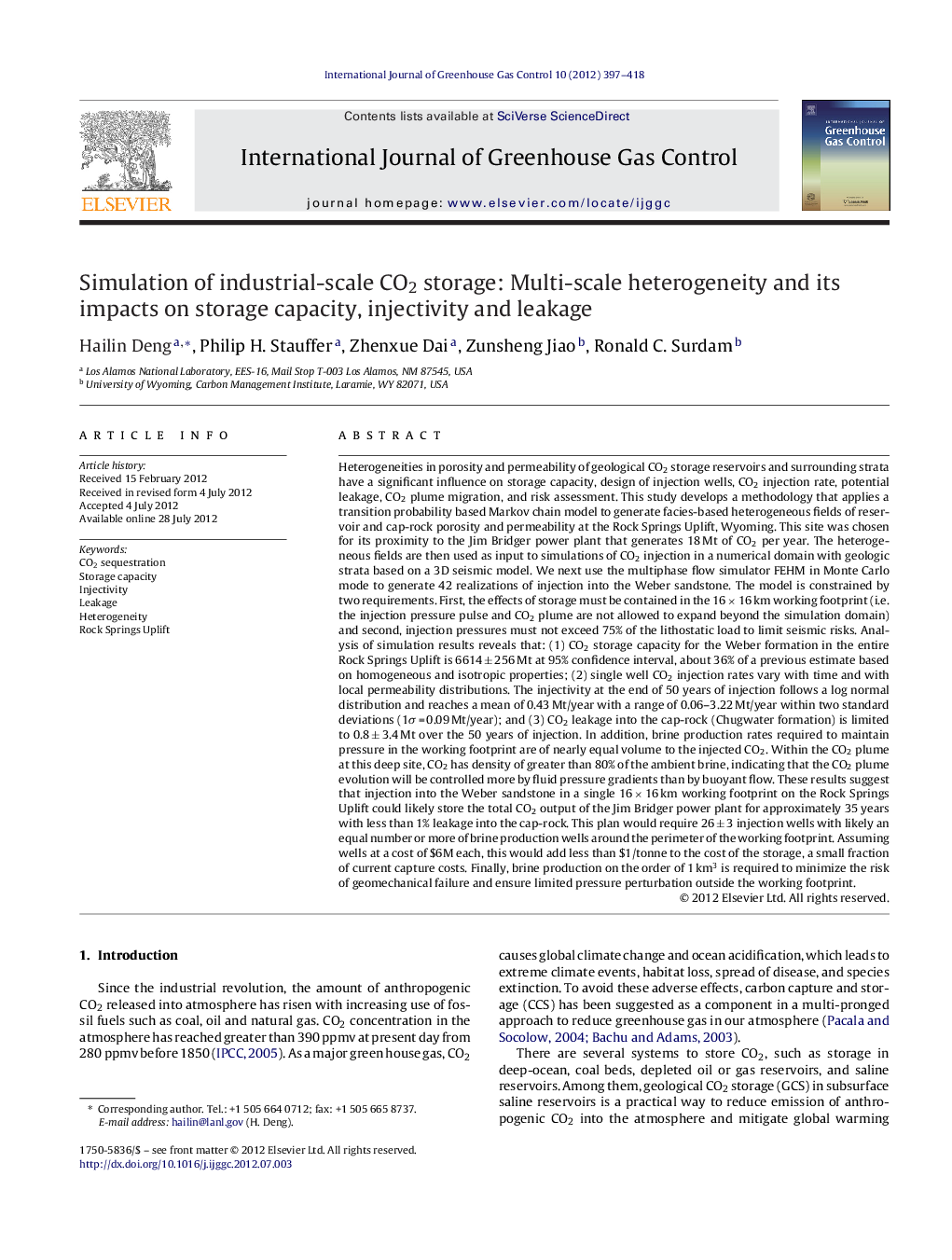| کد مقاله | کد نشریه | سال انتشار | مقاله انگلیسی | نسخه تمام متن |
|---|---|---|---|---|
| 1743316 | 1522013 | 2012 | 22 صفحه PDF | دانلود رایگان |

Heterogeneities in porosity and permeability of geological CO2 storage reservoirs and surrounding strata have a significant influence on storage capacity, design of injection wells, CO2 injection rate, potential leakage, CO2 plume migration, and risk assessment. This study develops a methodology that applies a transition probability based Markov chain model to generate facies-based heterogeneous fields of reservoir and cap-rock porosity and permeability at the Rock Springs Uplift, Wyoming. This site was chosen for its proximity to the Jim Bridger power plant that generates 18 Mt of CO2 per year. The heterogeneous fields are then used as input to simulations of CO2 injection in a numerical domain with geologic strata based on a 3D seismic model. We next use the multiphase flow simulator FEHM in Monte Carlo mode to generate 42 realizations of injection into the Weber sandstone. The model is constrained by two requirements. First, the effects of storage must be contained in the 16 × 16 km working footprint (i.e. the injection pressure pulse and CO2 plume are not allowed to expand beyond the simulation domain) and second, injection pressures must not exceed 75% of the lithostatic load to limit seismic risks. Analysis of simulation results reveals that: (1) CO2 storage capacity for the Weber formation in the entire Rock Springs Uplift is 6614 ± 256 Mt at 95% confidence interval, about 36% of a previous estimate based on homogeneous and isotropic properties; (2) single well CO2 injection rates vary with time and with local permeability distributions. The injectivity at the end of 50 years of injection follows a log normal distribution and reaches a mean of 0.43 Mt/year with a range of 0.06–3.22 Mt/year within two standard deviations (1σ = 0.09 Mt/year); and (3) CO2 leakage into the cap-rock (Chugwater formation) is limited to 0.8 ± 3.4 Mt over the 50 years of injection. In addition, brine production rates required to maintain pressure in the working footprint are of nearly equal volume to the injected CO2. Within the CO2 plume at this deep site, CO2 has density of greater than 80% of the ambient brine, indicating that the CO2 plume evolution will be controlled more by fluid pressure gradients than by buoyant flow. These results suggest that injection into the Weber sandstone in a single 16 × 16 km working footprint on the Rock Springs Uplift could likely store the total CO2 output of the Jim Bridger power plant for approximately 35 years with less than 1% leakage into the cap-rock. This plan would require 26 ± 3 injection wells with likely an equal number or more of brine production wells around the perimeter of the working footprint. Assuming wells at a cost of $6M each, this would add less than $1/tonne to the cost of the storage, a small fraction of current capture costs. Finally, brine production on the order of 1 km3 is required to minimize the risk of geomechanical failure and ensure limited pressure perturbation outside the working footprint.
► Rock Springs Uplift (RSU) is a pilot site for CO2 sequestration funded by DOE.
► CO2 storage capacity for Weber formation in RSU is 36% of a previous estimate.
► Single well CO2 injection rates vary with local permeability distributions.
► The mean injectivity for single well is 0.43 Mt/year with a range of 0.06–3.22 Mt/year within two standard deviations.
► CO2 leakage into the cap-rock is limited to 0.8 ± 3.4 Mt over 50 years of injection.
Journal: International Journal of Greenhouse Gas Control - Volume 10, September 2012, Pages 397–418